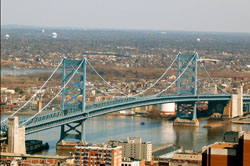Ben Franklin Bridge
|
| updated |
Copy Link Code
|
 Originally named the Delaware River Bridge, most people know it as the Benjamin Franklin Bridge. This suspension bridge connects Philadelphia, Pennsylvania and Camden, New Jersey. It was designed by a Polish-born engineer named Ralph Modjeski and completed in 1926. For just three years it was the longest suspension bridge in the world before the opening of the Ambassador Bridge that connects Detroit, Michigan and Windsor, Ontario. The Ben Franklin Bridge carries 7 lanes of traffic along with two rail lines and two sidewalks for pedestrians. The bridge is regulated by the Delaware River Port Authority (DRPA). The bridge utilizes a "zipper" barrier which is a concrete wall that can be mechanically moved and adjusted to separate lanes or block traffic from construction. Usually the barrier is used in the morning rush hour to allow for four lanes heading into Philadelphia and three to Camden with the reverse ratio in the evening rush hour. Traffic lights have been mounted on overhead gantries that tell drivers which lanes are open going their direction. Originally, there were fears of head-on collision as no barrier separated the opposing lanes of traffic.
Originally named the Delaware River Bridge, most people know it as the Benjamin Franklin Bridge. This suspension bridge connects Philadelphia, Pennsylvania and Camden, New Jersey. It was designed by a Polish-born engineer named Ralph Modjeski and completed in 1926. For just three years it was the longest suspension bridge in the world before the opening of the Ambassador Bridge that connects Detroit, Michigan and Windsor, Ontario. The Ben Franklin Bridge carries 7 lanes of traffic along with two rail lines and two sidewalks for pedestrians. The bridge is regulated by the Delaware River Port Authority (DRPA). The bridge utilizes a "zipper" barrier which is a concrete wall that can be mechanically moved and adjusted to separate lanes or block traffic from construction. Usually the barrier is used in the morning rush hour to allow for four lanes heading into Philadelphia and three to Camden with the reverse ratio in the evening rush hour. Traffic lights have been mounted on overhead gantries that tell drivers which lanes are open going their direction. Originally, there were fears of head-on collision as no barrier separated the opposing lanes of traffic.
The bridge's namesake, Benjamin Franklin, was a Founding Father and noted polymath who had lived in Philadelphia since the age of 17. Born in Boston in 1706, Franklin left for Philadelphia after a falling out with his older brother to whom he was apprenticed in a print shop. Franklin found success in Philadelphia and soon owned his own print shop along with a newspaper, The Pennsylvania Gazette. In his early adult life, Franklin led numerous efforts to advance the knowledge and prestige of local citizens. He helped establish the first subscription library in the world and also one of the first volunteer fire fighting brigades. After finding international success with his annual publication titled "Poor Richard's Almanack", Franklin continued to put his time and money into bolstering the community. He supplied much of the funding and wrote most of the charter for the Academy of Philadelphia, founded in 1751, which would go on to become the University of Pennsylvania. Franklin was also the Postmaster of Philadelphia and his success in optimizing the mail service earned him an appointment to become joint Deputy Postmaster-General of North America. Using his invention of the odometer, Franklin was able to find the fastest routes between towns and cities. Today, there are literally thousands of depictions of Benjamin Franklin in the public areas of Philadelphia where he is idolized as a sort of Grandfather of the city.
Benjamin Franklin's connection to New Jersey makes the bridge a bit ironic. While he did have enormous influence there through business and social connections, relations soured after his son became Governor of New Jersey and ruled as a staunch loyalist to the British. William Franklin, Benjamin's illegitimate son, had political views that were quite the opposite of his father's and would be exiled to England before the war's end. When he was first chased from New Jersey, William found safety in the loyalist bastion of New York whence he waged a retaliatory campaign against the rebels of his state. Benjamin Franklin would only see his son one more time while passing through London in 1785.
